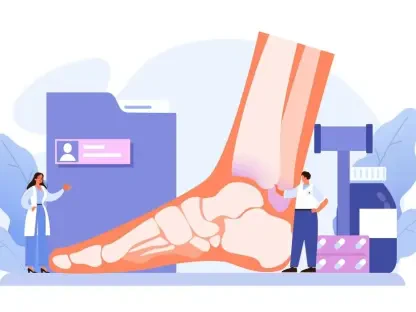Health inequities remain a significant challenge in the healthcare industry, affecting various demographic groups differently. The disparities in health outcomes across different populations emphasize the need to refine data collection and analysis methodologies. To effectively address these imbalances, it is crucial for stakeholders in the healthcare sector to adopt advanced strategies and tools. This article delves into expert insights and strategic approaches to improve data collection and analysis, ultimately aiming to achieve health equity.
The Importance of Data Sharing and Collaboration
Data sharing and collaboration among healthcare organizations, social service providers, and technologists are essential for equitable healthcare access. Timi Leslie, Executive Director at Connecting for Better Health, highlights California’s initiative where these entities work together in a community sandbox. This collaborative effort aims to validate and enhance data capabilities, serving as a reference model for high-priority use cases. By improving care coordination and whole-person care, such initiatives can significantly contribute to health equity.
Moreover, data sharing allows for a more comprehensive understanding of patient needs and disparities. When healthcare providers and social service organizations share data, they can identify gaps in care and address them more effectively. This collaborative approach ensures that all stakeholders are working towards a common goal of equitable healthcare outcomes. The integration of diverse data sources leads to a richer dataset that provides insights into various social determinants of health (SDoH), enabling more precise targeting of healthcare interventions.
Patient-Centered Care and Real-World Data Utilization
Patient-centered care is a critical component of achieving health equity. Diana Zuskov, Associate Vice President at LexisNexis Risk Solutions, advocates for the use of real-world data and interoperable data exchange to redefine how health equity insights are collected and utilized. She emphasizes the need to avoid overburdening providers, especially in underserved areas facing shortages and post-pandemic burnout. Instead, she suggests reimbursing providers for social needs screenings and leveraging data from diverse sources outside the healthcare context.
Real-world data include information from various sources such as social services, housing, and education, providing a more holistic view of a patient’s health. By integrating this data into healthcare systems, providers can better understand the social determinants that impact patient outcomes. This approach supports the delivery of patient-centered care by enabling more targeted interventions. The use of real-world data allows healthcare professionals to address the root causes of health disparities, rather than merely treating symptoms, thereby fostering a more effective and equitable healthcare system.
Addressing Social Determinants of Health (SDoH) Indirectly
Collecting SDoH data indirectly can help avoid introducing bias through AI algorithms. Mary Sirois, Managing Director at Nordic Consulting, suggests framing questions in patient portals to focus on solutions rather than problems. This method allows for the efficient collection of SDoH data without burdening patients or providers. Additionally, utilizing alternative data sources can improve equity in access to care.
Indirect collection methods can include using existing data from social services, community organizations, and public records. By analyzing this data, healthcare providers can identify social risks and address them proactively. This approach ensures that SDoH data is collected in a way that is both efficient and sensitive to patient needs. This strategy not only protects the integrity of the data but also minimizes the risk of patient fatigue, encouraging more consistent and accurate reporting.
Building Trust and Enhancing Communication
Building trust with patients and communities is crucial for accurate data collection. Leah Dewey, Vice President at Cotiviti, underscores the importance of year-round communication with members. She advocates for using digital surveys to gather data and update contact information. Tailoring communications to match the language, culture, literacy, and preferred methods of recipients can help address health inequities more effectively.
Effective communication strategies involve engaging with patients in a way that respects their cultural and linguistic preferences. This approach not only builds trust but also ensures that patients feel comfortable sharing their information. By maintaining open lines of communication, healthcare providers can gather more accurate data and better understand the needs of diverse populations. Moreover, ongoing engagement helps in identifying shifts in patient needs and perceptions, allowing for timely adjustments in care strategies that address emerging issues.
Longitudinal Tracking and Standardized Coding
Tracking patients longitudinally and documenting social risks using expanded Z codes can provide a comprehensive understanding of a patient’s journey. Sandeep Wadhwa, Global Chief Medical Officer at Solventum, emphasizes the importance of this approach in measuring outcomes such as preventable complications, readmissions, and mortality. Standardized coding practices ensure consistency in data collection and analysis, enabling healthcare organizations to identify and address health disparities more effectively.
Longitudinal tracking involves monitoring patients over time to observe changes in their health status and the impact of social determinants. This approach allows for the identification of trends and patterns that may not be apparent in cross-sectional data. By using standardized codes, healthcare providers can ensure that data is collected consistently, making it easier to compare and analyze across different populations. This method facilitates a more in-depth exploration of how social factors influence health, leading to more informed decision-making and resource allocation.
Defining Roles and Ensuring Sensitivity
Clearly defining roles within the healthcare workflow is essential for consistent data collection. Dana McCalley, VP at Navina, highlights the importance of this practice in ensuring that data is collected accurately and efficiently. She also emphasizes the sensitivity required when collecting SDoH data, recommending the use of discrete data points over free text for meaningful analysis.
Defining roles involves assigning specific responsibilities to healthcare team members for data collection and documentation. This approach ensures that data is collected systematically and reduces the risk of errors. Additionally, using discrete data points allows for more precise analysis and helps avoid the ambiguity that can arise from free-text entries. Proper training and clear guidelines for the team members can further enhance the accuracy and reliability of collected data, contributing to more effective strategies for addressing health inequities.
Leveraging Robust Datasets for Accurate Interventions
Robust datasets are crucial for uncovering gaps in care and implementing effective interventions. Brian Jones, Chief Growth Officer at Avēsis, emphasizes the need for leveraging comprehensive datasets that integrate SDoH metrics into electronic health records (EHRs). This integration facilitates the identification of health disparities and the development of targeted interventions tailored to specific demographics.
By examining these datasets, healthcare providers can identify patterns and trends that may not be immediately apparent. This in-depth analysis allows for the implementation of precise interventions designed to address the unique needs of different demographic groups. Robust datasets also enable predictive analytics, which can forecast potential health issues and allow for preemptive measures, ultimately improving patient outcomes and advancing health equity.
Utilizing AI for Comprehensive Analysis
Several experts, including Samir Awasthi, Vice President at Anumana, and Ankit Jain, CEO at Infinitus Systems, discuss the transformative potential of AI in analyzing vast datasets to identify and mitigate health disparities. AI technologies can sift through large volumes of data to uncover hidden patterns and correlations, providing insights that might otherwise go unnoticed.
The ethical use of AI is crucial to ensure that it amplifies equity rather than perpetuating biases. By training AI algorithms on diverse datasets and continuously refining them, healthcare organizations can leverage AI to address health disparities effectively. AI-driven analysis can highlight areas of need and suggest targeted interventions, leading to more equitable healthcare outcomes. The integration of AI in data analysis does not replace human expertise but augments it, supporting healthcare providers in making more informed and effective decisions.
Conclusion
Health inequities pose a significant challenge in the healthcare sector, affecting various demographic groups in different ways. These disparities highlight the urgent need to improve data collection and analysis methods to better understand and address the unique health outcomes across different populations. In order to tackle these imbalances effectively, it’s essential for stakeholders in the healthcare industry to embrace advanced strategies and tools.
To achieve health equity, such advancements can include utilizing big data analytics, leveraging artificial intelligence, and employing machine learning algorithms to gain deeper insights into health trends and patterns. Better data collection means capturing more comprehensive information about patients, their environments, social determinants of health, and the specific challenges faced by underserved communities.
By refining methodologies, healthcare professionals can identify gaps, predict future health issues, and develop targeted interventions to bridge those gaps. Collaborative efforts among healthcare providers, policymakers, and technology experts are crucial in ensuring that these advanced data strategies are implemented effectively.
Ultimately, the goal is to create a healthcare system that is responsive and equitable, where every individual, regardless of their background, has access to the quality care they need. Through improved data collection and analysis, we can work towards reducing health disparities and promoting a more just and effective healthcare landscape for all.









